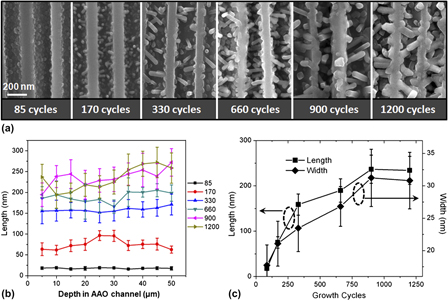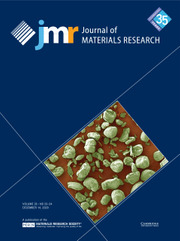Crossref Citations
This article has been cited by the following publications. This list is generated based on data provided by
Crossref.
Shi, Jian
Li, Zhaodong
Kvit, Alexander
Krylyuk, Sergiy
Davydov, Albert V.
and
Wang, Xudong
2013.
Electron Microscopy Observation of TiO2 Nanocrystal Evolution in High-Temperature Atomic Layer Deposition.
Nano Letters,
Vol. 13,
Issue. 11,
p.
5727.
Tan, Ai Wen
Pingguan-Murphy, Belinda
Ahmad, Roslina
and
Akbar, Sheikh Ali
2013.
Advances in fabrication of TiO2 nanofiber/nanowire arrays toward the cellular response in biomedical implantations: a review.
Journal of Materials Science,
Vol. 48,
Issue. 24,
p.
8337.
Tan, A.W.
Ismail, R.
Chua, K.H.
Ahmad, R.
Akbar, S.A.
and
Pingguan-Murphy, B.
2014.
Osteogenic potential of in situ TiO 2 nanowire surfaces formed by thermal oxidation of titanium alloy substrate.
Applied Surface Science,
Vol. 320,
Issue. ,
p.
161.
Tan, A.W.
Dalilottojari, A.
Pingguan-Murphy, B.
Ahmad, R.
and
Akbar, S.
2014.
In vitro chondrocyte interactions with TiO2 nanofibers grown on Ti–6Al–4V substrate by oxidation.
Ceramics International,
Vol. 40,
Issue. 6,
p.
8301.
Tan, A.W.
Pingguan-Murphy, B.
Ahmad, R.
and
Akbar, S.
2014.
Synthesis of bioactive titania nanofibrous structures via oxidation.
Materials Research Innovations,
Vol. 18,
Issue. sup6,
p.
S6-220.
Tan, A.W.
Pingguan-Murphy, Belinda
Ahmad, Roslina
and
Akbar, Sheikh
2014.
Surface Properties and Cell Response of Bioactive Thermally Grown TiO<sub>2</sub> Nanofibers.
Applied Mechanics and Materials,
Vol. 575,
Issue. ,
p.
219.
Xia, Ting
Zhang, Chi
Oyler, Nathan A.
and
Chen, Xiaobo
2014.
Enhancing microwave absorption of TiO2 nanocrystals via hydrogenation.
Journal of Materials Research,
Vol. 29,
Issue. 18,
p.
2198.
Liu, Gang
Yang, Hua Gui
Pan, Jian
Yang, Yong Qiang
Lu, Gao Qing (Max)
and
Cheng, Hui-Ming
2014.
Titanium Dioxide Crystals with Tailored Facets.
Chemical Reviews,
Vol. 114,
Issue. 19,
p.
9559.
Nikoobakht, Babak
and
Herzing, Andrew
2014.
Where is the required lattice match in horizontal growth of nanowires?.
Nanoscale,
Vol. 6,
Issue. 21,
p.
12814.
Wen, Kechun
and
He, Weidong
2015.
Can oriented-attachment be an efficient growth mechanism for the synthesis of 1D nanocrystals via atomic layer deposition?.
Nanotechnology,
Vol. 26,
Issue. 38,
p.
382001.
Yan, Xiaodong
and
Chen, Xiaobo
2015.
Encyclopedia of Inorganic and Bioinorganic Chemistry.
p.
1.
Rogé, Vincent
Georgantzopoulou, Anastasia
Mehennaoui, Kahina
Fechete, Ioana
Garin, François
Dinia, Aziz
Gutleb, Arno C.
and
Lenoble, Damien
2015.
Tailoring the optical properties of ZnO nano-layers and their effect on in vitro biocompatibility.
RSC Advances,
Vol. 5,
Issue. 118,
p.
97635.
Sadeghzadeh Attar, Abbas
and
Hassani, Zahra
2015.
Fabrication and Growth Mechanism of Single-crystalline Rutile TiO2 Nanowires by Liquid-phase Deposition Process in a Porous Alumina Template.
Journal of Materials Science & Technology,
Vol. 31,
Issue. 8,
p.
828.
Tan, Ai Wen
Liau, Ling Ling
Chua, Kien Hui
Ahmad, Roslina
Akbar, Sheikh Ali
and
Pingguan-Murphy, Belinda
2016.
Enhanced in vitro angiogenic behaviour of human umbilical vein endothelial cells on thermally oxidized TiO2 nanofibrous surfaces.
Scientific Reports,
Vol. 6,
Issue. 1,
Su, Yue
Zhang, Wei
Chen, Shanming
Yao, Danwen
Xu, Jilian
Chen, Xiaobo
Liu, Lei
and
Xu, Huailiang
2020.
Engineering black titanium dioxide by femtosecond laser filament.
Applied Surface Science,
Vol. 520,
Issue. ,
p.
146298.
Prakash, Jai
Samriti
Kumar, Ajay
Dai, Hongliu
Janegitz, Bruno C.
Krishnan, Venkata
Swart, Hendrik C.
and
Sun, Shuhui
2021.
Novel rare earth metal–doped one-dimensional TiO2 nanostructures: Fundamentals and multifunctional applications.
Materials Today Sustainability,
Vol. 13,
Issue. ,
p.
100066.
Lana, Gbemiga Matthias
Bello, Ismaila Taiwo
Adedokun, Omonike Mary
Adenigba, Victoria Olaide
Jubu, Peverga Rex
Adedokun, Oluwaseun
Sanusi, Yekinni Kolawole
Dhlamini, Mokhotjwa Simon
and
Awodugba, Ayodeji Oladiran
2024.
One-Dimensional TiO2 Nanocomposite-based Photoanode for Dye-Sensitized solar Cells: A review.
Solar Energy,
Vol. 279,
Issue. ,
p.
112850.



